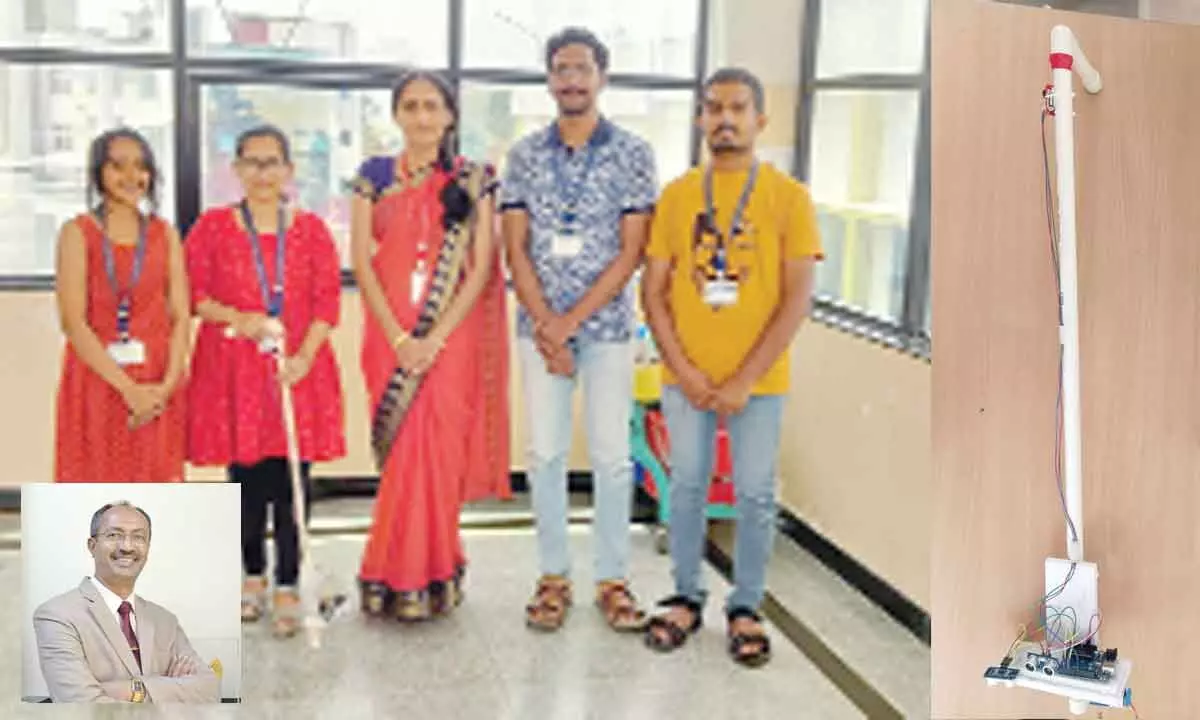Live
- CID's Counter Intelligence raids multiple places in J&K’s Anantnag, Kulgam districts
- India's growth on resilient trajectory, equity markets in consolidation phase
- KJo on 23 years of ‘Kabhi Khushi Kabhie Gham’: One of those pinch me moments
- WPL 2025 auction: Nandini, Kamalini set to be most sought-after names
- MP CM to inaugurate Sarsi resort in Shahdol, 200-bed hospital in Mauganj today
- TGPSC makes arrangements for Group-2 exams to be held tomorrow
- WPL 2025 Auction: When and where to watch, date, time, live streaming, venue
- Japan: Citizens protest US military-related sexual violence
- Buy on dips strategy working well in Indian stock market amid sharp rebound
- Sri Lanka concludes sovereign bond restructuring
Just In
Mysuru college students design 'new' stick for the blind


Prof B Sadashivegowda (Inset Pic)
Four students from Vidyavardhaka College of Engineering,Mysore have devised an automated stick for the blind.
Mysuru: Four students from Vidyavardhaka College of Engineering,Mysore have devised an automated stick for the blind. Constant worry aboutpotholes and obstacles has affected the confidence of the visually impairedindividuals while they step out of their home. This innovative stick helpsvisually impaired individuals be able to navigate swiftly identifying potholes and obstacles while out in crowded places.
This stick designed bythese four engineering students can a low cost, reliable, portable, low power consumption and robust solution for navigation with short responsetime.The ultrasonic sensor is the main feature of this device. The ultrasonicsensor transmits a sound pulse at high frequency, and then measures theperiod to obtain the sound echo signal to mirror back.Existing smart blindsticks have obstacle detection and pot-hole detection using ultrasonicsensor and digital image processing respectively leading to a problem ofdelay. The new stick devised by these students uses ultrasonic sensors forboth obstacle detection and pot-hole detection ensuring that the alerts aretimely.
SmrithiBaliga, a third year of Electronics and Communications engineeringat Vidyavardhaka College of Engineering who had once been involved inscribe writing for a blind student for an exam, was intrigued with theproblems faced by the blind student while crossing roads on the way to herexams. Teamed up with three other enthusiastic classmates, Sapna H M,Shreyas N, and Yogesh Gowda V, Smrithi came up with an idea to develop astick that helps visually impaired individuals reach their destination safely.
The product of this team's passion was an Internet of Things (IoT)based stick with an obstacle and pot-hole detection system using ultrasonicsensors. This project was implemented under the guidance of Dr.Chandrashekar M Patil Professor and Head Dept. of ECE and Girijamba D.L,Assistant Professor, Dept. of ECE at Vidyavardhaka College Of Engineering. Sapna H M said, "During an interaction with my school teacher two years agowe discussed about working on a project to help the blind. Concerned fortheir safety, we had interacted with blind kids during that time. After myfriend Smrithi discussed with me her concern about the safety of thevisually impaired we eventually came up with an idea of an automated stick
for them. We started with our research as soon as two other teammates too obliged the same. "
"As we researched for the project, we realized that the stick must be madeat a cost that is affordable by all considering the financial constraintsthat many might have. During our exploration through the possible methods,we found that although image processing could be used, the cost constraintsand delay in detection, we decided to deploy ultrasonic sensors forobstacle and pothole detection. Our team and our guide approved the same",she added. This stick is designed not only to be cost effective but also to be usableby people of all age groups. SmrithiBaliga "This stick is designed to beeasy to use for anyone and people of all age groups can use this stick. Itis light weight. We were determined to implement this project as ourpersonal interest in case this was not possible under an academic setting. Fortunately our project guides and college approved the project after wepresented the idea.""This project was completed in three phases in a span of four months.Presentation of the synopsis and cost estimation took us one month. For thenext one and half months we did the coding, mounting and threshold checkson the stick. We took another one and half months to work on the model" sheadded.
Shreyas N who did the coding for the automated stick said, "I have done thecoding for the stick using Arduino IDE using the threshold values providedby my friends. We are planning to improvise the voice outputs of the stick.We are also planning to make the stick more accessible for people agedbelow 18 years by making the length of the stick adjustable for theirheight too."
Yogesh Gowda V, who was incharge of design and implementation said, "Whilewe were referring to research papers relating to the project, we found outthat the sticks that were designed were heavier which makes it hard forusing the stick. We ensured that the stick that we designed should belighter and easily portable for all. I am happy that we were able to achieve what we proposed while initiating the project." Prof. B. Sadashivegowda, Principal at VVCE said, "We are proud about ourstudents for taking up the innovative project. In recent times technologyhas helped in improving healthcare across the world. Through this projectour students have proven how technology could be used to fight blindness.This automated blind stick devised by our students helps visually impairedindividuals to move freely with confidence."

© 2024 Hyderabad Media House Limited/The Hans India. All rights reserved. Powered by hocalwire.com






